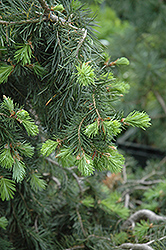It's all about ...
plants

Emerald Twister Douglas Fir
Pseudotsuga menziesii 'Emerald Twister'
Height: 20 feet
Spread: 12 feet
Sunlight:
![]()
Hardiness Zone: 4a
Description:
A compact evergreen with attractive fine bluish needles on a uniquely twisting irregular form; looking like a living sculpture, it is the perfect garden or landscape accent; prefers moist and humid environments, give some shelter from drying winds
Ornamental Features
Emerald Twister Douglas Fir is primarily valued in the landscape for its ornamental upright and spreading habit of growth. It has attractive bluish-green evergreen foliage which emerges light green in spring. The needles are highly ornamental and remain bluish-green throughout the winter.
Landscape Attributes
Emerald Twister Douglas Fir is a multi-stemmed evergreen tree with an upright spreading habit of growth. Its relatively fine texture sets it apart from other landscape plants with less refined foliage.
This is a relatively low maintenance tree. When pruning is necessary, it is recommended to only trim back the new growth of the current season, other than to remove any dieback. Deer don't particularly care for this plant and will usually leave it alone in favor of tastier treats. It has no significant negative characteristics.
Emerald Twister Douglas Fir is recommended for the following landscape applications;
- Accent
- Vertical Accent
- General Garden Use
Planting & Growing
Emerald Twister Douglas Fir will grow to be about 20 feet tall at maturity, with a spread of 12 feet. It has a low canopy with a typical clearance of 2 feet from the ground, and is suitable for planting under power lines. It grows at a medium rate, and under ideal conditions can be expected to live for 80 years or more.
This tree should only be grown in full sunlight. It requires an evenly moist well-drained soil for optimal growth, but will die in standing water. It is not particular as to soil type, but has a definite preference for acidic soils. It is somewhat tolerant of urban pollution, and will benefit from being planted in a relatively sheltered location. Consider applying a thick mulch around the root zone in winter to protect it in exposed locations or colder microclimates. This is a selection of a native North American species.
This plant is not reliably hardy in our region, and certain restrictions may apply; contact the store for more information.
